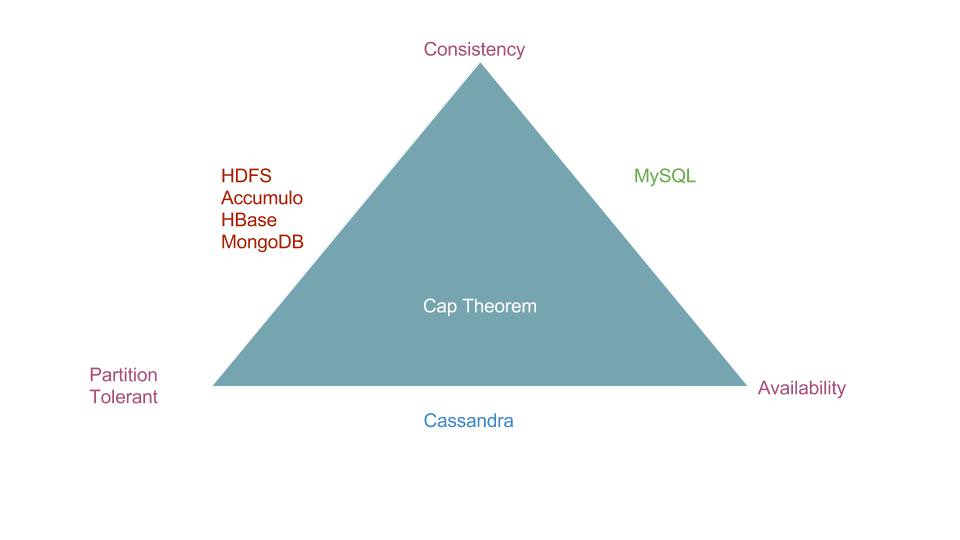There are core basics that every organization needs that leads to a basic standard implementation of a Big Data solution. However, that basic implementation will not provide the best performance for the user in all use cases and situations. There are so many different options now that choosing between all of them can be complicated. There is Apache Cassandra, HBase, Accumulo, MongoDB or the typical relational databases such as MySQL. Knowing when to use which technology can be tricky. The basic implementation that I have seen is the Lambda Architecture with a batch layer, speed layer and view layer. Hadoop is primarily used as the storage in the batch layer and Cassandra for the view layer. In many cases this architecture will provide the user with the best performance but some analysis should always be done on the overall use case and business needs to determine what Big Data database is best or if a relational database will be best.
Cap Theorem
When examining Big Data solutions that will work for your organization one of the most important theorem to use is the CAP theorem. The CAP theorem explains that there needs to be trade offs between consistency, availability and partition tolerance in a system. Normally it is said that only two can be achieved. However, in truth levels of all three can in fact be achieved but high levels of all three is impossible. When a query is executed against all the nodes of a system simultaneously and the same data will be returned, the system is considered consistent. Availability is achieved when a request to write to the system will always succeed. The final trade off is for partition tolerance, where the system will be able to operate as normal in case of a network failure. A partition tolerant system is one that scales horizontally by adding more nodes to the system, versus scaling vertically by adding more hardware to the system such as increased memory or storage. This system will be able to recover if there are more partitions added and data is further split between nodes.
If consistency and availability are the two most important aspects to your application for a database, a typical relational database such as MySQL would be best. This choice is good when a low amount of complex queries are necessary. Relational databases can be slow to respond when running complex queries due to the hardware cost of running. For example queries that aren’t written properly can be slow if joins are performed over a non filtered dataset because the dataset is too large. Lookup tables are an excellent use case for a relational database because typically lookups are simple queries where extra information is needed based on one or two specific values. An example of this can be looking up the address for an individual based on their unique identifier for the system.
All databases that are Big Data solutions are partition tolerant and therefore must balance between being consistent and available. Choosing between availability and consistency is not necessarily a one to one choice. Most solutions have high availability and low consistency or vice versa. Therefore, the main choice is what do you need more, a system that has high availability and eventual consistency or a very consistent application that is mostly available.
One example of a highly available and eventually consistent application is Apache Cassandra. Apache Cassandra is a column oriented structured database. You can choose the consistency level for the Cassandra nodes. The less nodes need to be consistent on a write the more available the system is. When you choose to write and read to only one node for a success which provides the highest level of availability, there is a concept in Cassandra of a read repair. When a read happens in Cassandra there is a background process that determines if the replication has the most current data. If the data is incorrect this process will correct the replication so it has the correct data which will allow the nodes to become consistent with the others. For users this means that if each node is queried after an update different data may be returned as not all the nodes were updated. If one of these nodes goes down, outdated data could be returned to the application. However, there will always be a response from the application which makes Cassandra highly available. A good example of a use case for this would be a historical summary view of data where the data is not likely to change often. Many times a Cassandra database will also be consistent but there are also times where Cassandra won’t be.
There are many databases that are considered to be highly consistent but not highly available. HDFS is an example of storage that is highly consistent but not highly available. If a server with the NameNode was to experience network failure then all jobs that are currently in progress or the ability to access the data for a MapReduce job will fail. This causes HDFS to have a lower availability than other databases such as Cassandra. Having multiple NameNodes can mitigate this risk and have higher availability. If HDFS is queried when there is a network issue to the NameNode, no response will be given to the user. There will only be a timeout.
Other examples of highly consistent but not highly available databases are Apache Accumulo and Apache HBase. Apache Accumulo and HBase are solutions that are based on Google’s BigTable. These types of implementation are built on top of HDFS and use HDFS to store the data. Therefore, these databases are constricted by the availability of HDFS.
A final database solution that is highly consistent but not highly available that is used a lot is MongoDB. MongoDB operates in a primary, secondary architecture. When the primary nodes goes down, the system will choose another secondary to operate as the primary. The primary is the first to receive any writes to the system so to maintain consistency when the primary node fails any writes to the system will not be accepted causing the system to appear unavailable. This protects the system against a secondary having data that the primary node does not have once the primary comes back on. Primary generally restores from outages in a few seconds.




